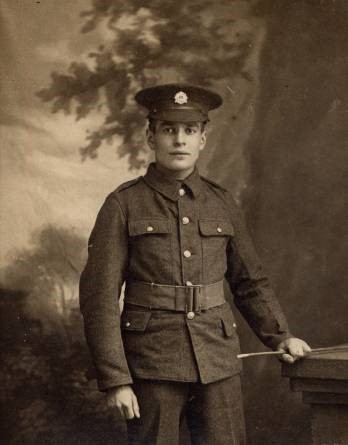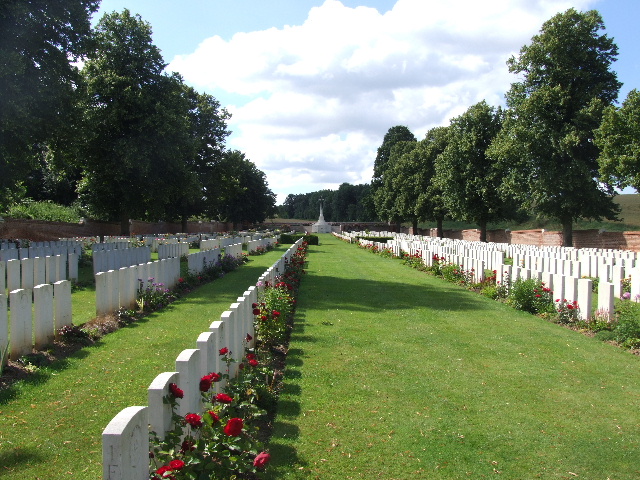Name
Sidney Baines
Conflict
First World War
Date of Death / Age
13/11/1916
23
Rank, Service Number & Service Details
Private
26026
Bedfordshire Regiment
4th Bn.
Awards: Service Medals/Honour Awards
British War and Victory medals
Cemetery/Memorial: Name/Reference/Country
ANCRE BRITISH CEMETERY, BEAUMONT-HAMEL
I. C. 26.
France
Headstone Inscription
Not Researched
UK & Other Memorials
Pirton Village War Memorial,
St Mary’s Shrine, Pirton,
Methodist Chapel Plaque,
Pirton Pirton School Memorial
Biography
Sidney was the son of Albert and Emma Elizabeth Baines (née Weeden), their fifth child and born on March 27th 1891. The 1911 census confirms ten children(*1), but by then one had died. Five were sons, but only Sidney and Fred, who survived, appear to have served. Both attended the Pirton School and are remembered on its memorial.
Their father worked on the local farms until some time after 1901 when he became a roadman for Hertfordshire County Council. They lived in one of the cottages known as ‘Ten Steps’, which were a row of four small cottages in Shillington Road. They were built in the mid 18th century and demolished in 1980 to make way for new houses near where number 13 is today. After leaving school Sidney also became a farm worker.
David Baines, who has a particular interest in the local soldiers appearing on the Hitchin War Memorials, was able to add that ‘As an adult Sidney moved to Hitchin and married Ethel Lily Elms’. Ethel formerly lived at the Grange, Shillington, Hitchin, Herts. A local paper recorded that he had been working at Letchworth Woodworkers and then at Phoenix – probably Phoenix Motors Ltd, who made the Phoenix motor car in Letchworth, before enlisting on February 9th 1916. According to the Parish Magazine he enlisted in Bedford and served in the 4th Bedfordshires. He survived approximately eight months, but that of course included some months of training.
The terrible losses in the early days of the Battle of the Somme(*2) (July 1916) meant that large numbers of troops were desperately needed to return to strength. The 4th Battalion of the Bedfordshire Regiment was a special reserve battalion providing home defence around Harwich, but men were needed so they were called to France and landed there on July 25th 1916. Sidney was probably with them.
The Battalion’s war diary held by the National Archives does not start until September 1916 and so they seem to have entered the firing line for the first time on the 11th as relief for the Royal Fusiliers at Calonne. They came out of the line on the 15th, moving to reserve trenches at Bully Grenay, then moved to Coupigny, Dieval and then Orlencourt. The month of October is not available, but they would have seen action. November 2nd saw them in the front line at Knightsbridge – a trench system named after Knightsbridge Barracks and near where John Parsell had been buried two months earlier. On the 3rd they were relieved at 11:00am and moved to Englebelmer, resting until the 7th, when they marched to Hedeauville and then Puchvillers where they stayed until the afternoon of the 11th when they once again moved on, this time to Varennes. Here they waited in the assembly trenches near Bedford Street and Victoria Street (trenches), for the forthcoming major attack being launched between Beaumont Hamel and the River Ancre on the 13th – this was in the Somme and this battle became known as the Battle of the Ancre.
After a nerve-racking night the heavy barrage commenced on the enemy lines at 5:45am. The enemy responded, killing men in the support line. After an hour the men were ordered to attack. ‘The Battalion advanced with the remainder of the Brigade at 6.45am and sustained heavy casualties among Officers and NCOs in and near the enemy front line from a strongpoint established between enemy front line and second line which had been passed over by the leading Brigades. Battalion advanced to enemy second line and from there parties pushed forward to Station Road and beyond.’
Fourteen officers were killed and in the other ranks 108 men were wounded, 16 were missing and 48 killed, including Sidney. He may have died in the attack or from the earlier shelling of the support line.
Officially his wife was told that he was missing, but Private Stapleton from Holwell wrote to her telling her he had been killed. She must have desperately hoped that he was mistaken. She had just received a letter from him written on the 10th, only three days before his death.
His body lies in Ancre British Cemetery, which is about 1 ½ miles south of the village of Beaumont-Hamel. It lies to the side of a quiet country road between Albert and Achiet-le-Grand. The graves are unsighted from the road, but it has an impressive, formal, brick and stone entrance with double rising steps leading to the elevated cemetery. Its proportions are long and thin and set at right angles to the road. As you mount the steps long lines of headstones, edge on, lead the eyes away into the distance.
It is another cemetery to which men from other burial sites were brought after the war. It originally held 517 graves, but now contains the graves or memorials to 2,540 Commonwealth casualties of the First World War. 1,206 men’s graves are named, memorials commemorate 43 casualties known or believed to be buried among them and there are special memorials to 16 casualties who were known to have been buried in other cemeteries, but whose graves were destroyed by shell fire. The rest are ‘Known Unto God’.
(*1) Charlie (bapt 1885), Mary (b-1886), Ida (b 1888 and who died in infancy), Fred (b 1890), Sidney (b 1891), Rose (b 1895), Edward (b 1897), Lily (b 1900), Harry (b 1902) and Hilda (b 1906).
(*2) By the end of the first day of the Battle of the Somme (July 1st) there had been 57,470 casualties, including 19,240 men killed. It had been, and still is, the blackest day in the British Army’s history.
Additional Information
Text from the book: The Pride of Pirton
Acknowledgments
The Pride of Pirton book – www.pirton.org.uk/prideofpirton Chris Ryan / Tony French / Jonty Wild



